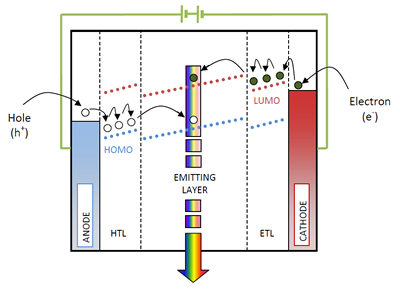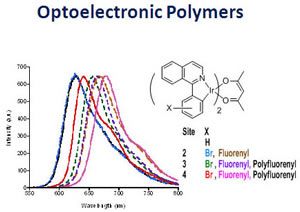Conjugated, electroactive polymers are attracting considerable attention as low cost and sustainable alternatives to conventional metal semiconductors in light emitting devices (LEDs), transistors (FETs) and solar cells (photovoltaics, PV).
Conjugated polymers show real promise as the active material for the next generation of information technology based consumer products and for harvesting of solar energy in photovoltaics. The principle interest in the use of these polymers lies in the scope for low-cost, large surface area manufacturing, facilitated by solution-processing of film-forming materials. The widespread commercialization of these polymers is dependent on improving device efficiencies and it is also of fundamental interest to gain insights into their chemistry and physics.

Recently, the Williams group have reported a new class of organometallic iridium complexes which are covalently linked to conjugated polymers and show red light emission. The polymer complexes are important because they are single component electronics; they show enhanced properties vs. blends. We have also carried out a detailed study (synthesis, photophysics, DFT) into the relationship between the regiochemistry and type of substituent on the iridium complex which uncovered the factors governing light emission. In collaboration with the Optoelectronics group in the Cavendish laboratory in Cambridge, the new polymer complexes have emerged as useful tools for understanding the fundamental photophysical processes occurring in polymer solar cells.

-
Keyworth, C. W.; Chan, K. L.; Labram, J. G.; Anthopoulos, T. D.; Watkins, S. E.; McKiernan, M.; White, A. J. P.; Holmes, A. B.; Williams, C. K., J. Mater. Chem. 2011, 21, 11800
-
Donaghey, J. E.; Ashraf, R. S.; Kim, Y.; Huang, Z. G.; Nielsen, C. B.; Zhang, W.; Schroeder, B.; Grenier, C. R. G.; Brown, C. T.; D'Angelo, P.; Smith, J.; Watkins, S.; Song, K.; Anthopoulos, T. D.; Durrant, J. R.; Williams, C. K.; McCulloch, I., J. Mater. Chem. 2011, 18744
-
Albert-Seifried, S.; Hodgkiss, J. M.; Laquai, F.; Bronstein, H. A.; Williams, C. K.; Friend, R. H., Phys. Rev. Lett. 2010, 105, 195501
- Howard, I. A.; Hodgkiss, J. M.; Zhang, X.; Kirov, K. R.; Bronstein, H. A.; Williams, C. K.; Friend, R. H.; Westenhoff, S.; Greenham, N. C. J. Am. Chem. Soc. 2010, 132, 328.
- Westenhoff, S.; Howard, I. A.; Hodgkiss, J. M.; Kirov, K. R.; Bronstein, H. A.; Williams, C. K.; Greenham, N. C.; Friend, R. H. J. Am. Chem. Soc. 2008, 130, 13653.
- Bronstein, H. A.; Finlayson, C. E.; Kirov, K. R.; Friend, R. H.; Williams, C. K. Organometallics 2008, 27, 2980.